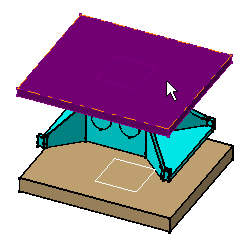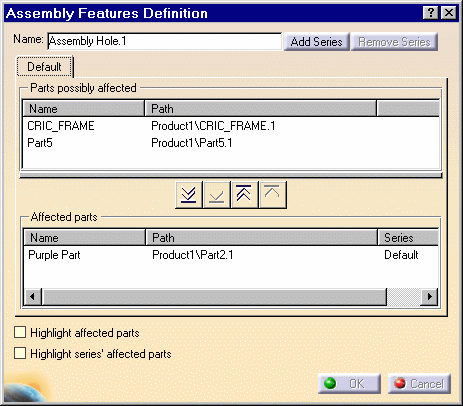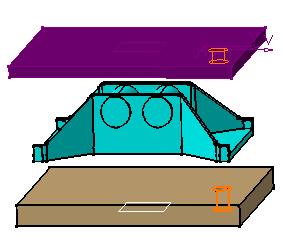-
Select the purple face as shown to define the location of the hole:

The Assembly Features Definition dialog box appears.

The dialog box displays the names as well as the paths of the parts that may be affected by the hole creation.
The assembly feature's name appears in the Name field. If desired, you can edit this name.
The frame Affected parts is exclusively reserved for the parts you wish to use. Purple Part is displayed in this frame.
Note that the Hole Definition dialog box is displayed.
-
As you wish to create a hole between Part5 and Purple Part, move Part5 to the list Affected parts.
The other three buttons lets you move the names of the parts from one list to another too:
-
 moves all
selected parts to the list Affected parts.
moves all
selected parts to the list Affected parts. -
 moves all
selected parts to the list Parts possibly affected.
moves all
selected parts to the list Parts possibly affected. -
 moves the
selected part to the list Parts possibly affected.
moves the
selected part to the list Parts possibly affected.
-
Check the option Highlight affected parts to clearly identify the parts.
At this point, you can now define the hole you wish.

You cannot edit the hole positioning sketch from
the assembly hole definition, this why the icon still grayed.
If you wish to edit it, double-click the Positioning Sketch
created in the part from which you have defined the assembly hole, or edit
the reused hole.
Whatever hole you choose, you need to specify the limit you want. If you do not specify a depth value, four types of limits are available:
|
-
Set the Up to Last option. The application extends the hole from the sketch plane to the last face encountered.
-
Enter 25mm as the diameter value.
By default, the application creates the hole normal to the sketch face. But you can also define a creation direction not normal to the face by deselecting the Normal to surface option and selecting an edge or a line.
If you are designing a blind hole, you can set the Bottom option to V-Bottom to create a pointed hole and then enter the angle value of your choice.
Clicking the Type tab lets you create the following holes:
|
Make sure the option Simple is set.
Clicking the Thread Definition tab lets you access to the options defining threads. For more information about threads and holes, please refer to Part Design User's Guide.
-
Click OK to confirm.
The hole is created on Part 5 and Purple Part. Conversely, CRIC_FRAME is intact.

A new entity Assembly features appears in the specification tree. It contains the assembly hole referred to as Assembly Hole.1 and the affected parts.
Moreover, this feature has generated a hole in
each part. An arrow symbol identifies these holes
![]() in the tree,
meaning that a link exists between Assembly Hole.1and them.
in the tree,
meaning that a link exists between Assembly Hole.1and them.
Editing an Assembly Hole
- modify the list of affected parts.
- edit the hole.
Reusing Part Design Holes
- You cannot reuse hole for which the reference geometry for creation is not a planar surface.
- You cannot reuse a hole with the Up to next option, because this option is not applicable for assembly hole.
- You cannot re-affect an assembly hole on the part which contains the part hole, except if the diameter of the assembly hole exceed the diameter of the part hole, or if the assembly hole location is different. In fact, you cannot drill vacuum.
-
Click the Hole icon:

-
Select the Part Design hole of interest.
-
Both the Hole Definition and the Assembly Features Definition dialog boxes display. You then just need to specify the parts to pierce.
The assembly hole inherits the specifications as displayed in the Part Design Hole Definition dialog box. You can edit these specifications at any time. Editing an Assembly feature created in this way does not affect the specifications used for the Part Design feature.








